Bio Part 4: Grand Guignol, TV, Last Years, Legacy
Grand Guignol and TV: 1960 - 1972
1960, the year following husband Al Steele's death, brought more emotional turmoil for Joan: longtime friend and lover Clark Gable died suddenly after filming The Misfits; and Redbook magazine published daughter Christina's griefs in a long article, "The Revolt of Joan Crawford's Daughter." (Christina would expand upon this article at book-length after Joan's death.)

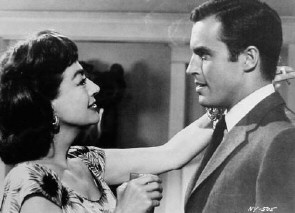 When
good film roles didn't come her way at the beginning of the decade, Joan again
took matters into her own hands. In late 1961,
Joan paid a backstage visit to Bette Davis, then appearing on Broadway. Joan
mentioned a book that she'd just read, What Ever Happened to Baby Jane,
and suggested that it might be a suitable film vehicle for the two stars. Six
months later, the film was in production, with Robert Aldrich directing. Davis
played former child star Baby Jane Hudson, with Joan as Jane's once-top-star
sister now dependently wheelchair-bound, in a harrowing psychological drama
of sisters unable to escape from their life together. Relations between
Joan and Davis were coolly cordial on the set, but the film was surprisingly
hot upon its release, garnering not only good box office but also several Oscar
nominations, including one for Davis as Best Actress.
When
good film roles didn't come her way at the beginning of the decade, Joan again
took matters into her own hands. In late 1961,
Joan paid a backstage visit to Bette Davis, then appearing on Broadway. Joan
mentioned a book that she'd just read, What Ever Happened to Baby Jane,
and suggested that it might be a suitable film vehicle for the two stars. Six
months later, the film was in production, with Robert Aldrich directing. Davis
played former child star Baby Jane Hudson, with Joan as Jane's once-top-star
sister now dependently wheelchair-bound, in a harrowing psychological drama
of sisters unable to escape from their life together. Relations between
Joan and Davis were coolly cordial on the set, but the film was surprisingly
hot upon its release, garnering not only good box office but also several Oscar
nominations, including one for Davis as Best Actress.
Unfortunately, though a financial bonanza personally, the success of Baby Jane failed to translate into better roles for Joan. Instead, the film seemed to initiate a cycle of Grand Guignol that Joan obviously felt compelled to act in for both egotistical and financial reasons. 1963's The Caretakers provided a small, grim part as a rigid nurse in a psychiatric ward. The pleasant schlockmeister William Castle then offered two roles to Joan, in 1964 and '65: In the former, Strait-Jacket, she plays a convicted ax murderess who returns home after 20 years, only to discover a fresh crime-wave overtaking the family farm. In the latter, I Saw What You Did, she's an older woman struggling to hang on to her wicked lover, only to be offed before the film's halfway done because some teenage prank callers have provoked the man's paranoia.
Strait-Jacket, especially, is an interesting example of Joan giving an "A" performance in a decidedly "B" picture: Despite the head-lopping shenanigans going on around her, her mother character is appropriately gray and troubled and sensitive...until she gets a few drinks in her. The scene where the bracelet-jangling, scotch-swilling Lucy Harbin blatantly comes on to her daughter's boyfriend then strikes a match off a playing record is prime Crawford that stands up acting-wise to her most watchable scenes of her '30s and '40s heyday.
After a 3-year movie hiatus (except for 1967's Karate Killers, a US TV episode released theatrically in Europe), Joan appeared in Berserk, a Herman Cohen production filmed in Britain, with Joan as the owner and ringmistress of a circus gone terribly awry, complete with a murderous daughter and the requisite untrustworthy stud. Despite the incredibly cheesy plot (no, Ty Hardin would most likely not be completely enamoured of a sarcastic 60-something woman playing hard-to-get), Berserk (as with Strait-Jacket) is a good example of Joan working her star-quality with effective results: One might mock the film's proceedings, but Joan in action remains fascinating. Unfortunately, Joan's last film Trog (1970), another Cohen picture, offers nothing particularly redeeming: Bad plot and writing, cheesily outfitted troglodyte, bland Joan-as-scientist.
Said Joan later regarding her films following Baby Jane:
They were all terrible, even the few I thought might be good. I made them because I needed the money or because I was bored or both. I hope they have been exhibited and withdrawn and are never heard from again. If I weren't a Christian Scientist, and I saw Trog advertised on a marquee across the street, I think I'd contemplate suicide.
The post-Baby Jane-to-1972 period also saw the beginning of the solidification of Joan's legacy with the publication of several Joan-related books: The 1962 autobiography Portrait of Joan; 1968's The Films of Joan Crawford; and 1971's autobiography/helpful-hints-guide My Way of Life. Another homage was her 1969 Cecil B. DeMille award, bestowed by the Golden Globes for her body of work.
 While Joan made
only 6 films between 1960 and 1970, her work in the new medium of television
was constant and prolific during this same period, keeping her both busy and
in the public eye.
While Joan made
only 6 films between 1960 and 1970, her work in the new medium of television
was constant and prolific during this same period, keeping her both busy and
in the public eye.
Joan had been appearing on TV regularly since 1953, on programs such as Revlon's Mirror Theater, GE Theater, the Colgate Variety Hour, Caesar's Hour, and the Zane Grey Theater, as well as Steve Allen's Tonight Show. In the '60s and early '70s, she continued to be a regular guest on various talk shows, including the debut episode of Johnny Carson's Tonight Show in 1962 as well as numerous stints on Merv Griffin, Mike Douglas, Girl Talk, and David Frost. Other appearances included game shows like What's My Line and I've Got a Secret; Lucille Ball's comedy show (1968); and guest spots on various dramatic programs such as The Man From U.N.C.L.E. (1967), Night Gallery (1969, in the episode "Eyes," which marked the directorial debut of Steven Spielberg), and The Virginian (1970). One of her most infamous appearances was in 1968, when she voluntarily, and rather embarrassingly, filled in for a week for ailing daughter Christina on the daytime soap "The Secret Storm." Joan's last television role was on 1972's mystery program The Sixth Sense, in an episode entitled "Dear Joan, We're Going to Scare You to Death." From 1953 to 1972, Joan made over 100 television appearances.
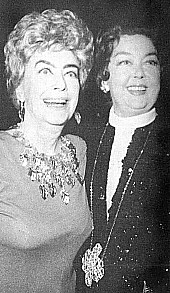
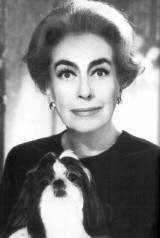 Joan's public
and private lives began to constrict in 1973. One of her last public appearances was
in April of that year at New York City's Town Hall, in a "Legendary Ladies" event hosted by John Springer, where she answered
questions from Springer and the audience. That same month, the new head of
Pepsi-Cola, with whom she'd had an antagonistic relationship since Al Steele's
death, forcibly
retired her from the company's board of directors after her 18 years of service
for Pepsi. In September of '73, financial considerations forced Joan to
take a smaller apartment in the Imperial House, where she'd lived since the
mid-60s.
Joan's public
and private lives began to constrict in 1973. One of her last public appearances was
in April of that year at New York City's Town Hall, in a "Legendary Ladies" event hosted by John Springer, where she answered
questions from Springer and the audience. That same month, the new head of
Pepsi-Cola, with whom she'd had an antagonistic relationship since Al Steele's
death, forcibly
retired her from the company's board of directors after her 18 years of service
for Pepsi. In September of '73, financial considerations forced Joan to
take a smaller apartment in the Imperial House, where she'd lived since the
mid-60s.
September 23, 1974, was Joan's final public appearance, in an event at NYC's Rainbow Room to honor Rosalind Russell. After seeing unflattering press photos of herself published the next day, she was horrified, saying "If that's how I look, they won't see me again." And the public didn't.
Joan reportedly gave up drinking in December of 1974 and rarely left her apartment after that year, though she wasn't a complete recluse; until the end of 1976 she would regularly visit with neighbors, and friends like artist Russ Elliott, editor Carl Johnes (who later published a warmly honest book about their relationship), publicist Michael Sean O'Shea, and makeup artist Monty Westmore, as well as her Christian Science practitioner Mrs. Markham, her longtime secretary, and her daughter Cathy and family. She also continued to speak to interviewers like Roy Newquist (who later published Conversations with Joan Crawford) and magazines such as Architectural Digest, which did a feature on her apartment in the fall of 1975.
By early 1977, though, even these contacts had mostly tapered off, as did her once-numerous phone calls to friends.
A sign that Joan herself recognized that her life was almost over came on May 8, when she gave away her beloved pet Shih Tzu. Two days later, on the morning of May 10, Joan Crawford died. Only her housekeeper and a longtime female fan were present. The coroner listed the cause of death as "acute coronary occlusion," but Joan had been noticeably wasting away for months and several sources list the actual cause of death as liver cancer. Suicide was also suspected because of the symbolic importance of the date---her and Al Steele's wedding anniversary. She was cremated and her remains interred at New York's Ferncliff Mausoleum, alongside those of Steele.
The public farewell to Joan began appropriately enough: The New York Times ran a 2000-word front-page obituary and the national nightly news shows also covered her death. On Friday, May 13th, the head of the Motion Picture Authority, Jack Valenti, called for a moment of silence in her honor on all Holllywood lots. That same Friday, a private funeral was held for her in NYC, attended by all four of her children, her niece, and around 75 others. A public New York memorial service was held at the All Souls Unitarian Church, attended by 1500 people, with speakers including Cliff Robertson, Anita Loos, and Geraldine Brooks, and a song by Pearl Bailey. A Beverly Hills memorial service was held June 24. Director George Cukor organized the gathering and read an inspired tribute:
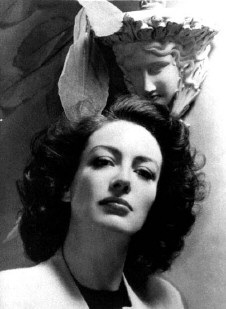 ...She
was the perfect image of the movie star, and, as such, largely the creation
of her own indomitable will. She had, of course, very remarkable material to
work with: a quick native intelligence, tremendous animal vitality, a lovely
figure and, above all, her face, that extraordinary sculptural construction
of lines and planes, finely chiseled like the mask of some classical divinity
from fifth-century Greece. It caught the light superbly, so that you could photograph
her from any angle, and the face moved beautifully....The nearer the camera,
the more tender and yielding she became---her eyes glistening, her lips avid
in ecstatic acceptance. The camera saw, I suspect, a side of her that no flesh-and-blood
lover ever saw....I thought Joan Crawford would never die. Come to think of it, as long as celluloid holds together and the word
Hollywood means anything to anyone, she never will.
...She
was the perfect image of the movie star, and, as such, largely the creation
of her own indomitable will. She had, of course, very remarkable material to
work with: a quick native intelligence, tremendous animal vitality, a lovely
figure and, above all, her face, that extraordinary sculptural construction
of lines and planes, finely chiseled like the mask of some classical divinity
from fifth-century Greece. It caught the light superbly, so that you could photograph
her from any angle, and the face moved beautifully....The nearer the camera,
the more tender and yielding she became---her eyes glistening, her lips avid
in ecstatic acceptance. The camera saw, I suspect, a side of her that no flesh-and-blood
lover ever saw....I thought Joan Crawford would never die. Come to think of it, as long as celluloid holds together and the word
Hollywood means anything to anyone, she never will.
Joan Crawford's legacy seemed assured: A luminously intense screen presence whose looks, talent, and willingness and ability to change with the times and screen trends guaranteed her a permanent place in the celluloid firmament, an eternally-captured brilliant example of not only Hollywood's Golden Age, but also the industry's triumphs and travails over an incredible 45-year span.
But the business of Legacy in Joan's case wasn't meant to be quite so uncomplicated...
On the evening after her New York funeral service was held, Joan's will was read to her family members. Joan left $77,500 each to her twin daughters Cathy and Cindy. Smaller sums went to loyal friends and her secretaries. Greater amounts were left to various local and national charities. And the 10th codicil of her will stated, "It is my intention to make no provision herein for my son Christopher or my daughter Christina for reasons which are well known to them."
Ouch. Daughter Christina took umbrage at the snub, and in the fall of 1978 her vengeful, tell-all memoir Mommie Dearest was released, in which she excoriated Mommie Joan for wrongs ranging from late-night drunken rampages to forcing daughter dearest to--gasp!--write thank-you notes for gifts! The book was a huge hit, staying on the NY Times bestseller list for 42 weeks and selling millions of copies. The over-the-top movie version, starring Faye Dunaway as an unhinged ax-wielding Joan, was released 3 years later, in the fall of 1981, to immediate howls of both camp glee and protest. (In 1982, the movie was nominated for a then-record 8 "Razzie" awards for downright bad filmmaking and in 1990 received the Razzie for "Worst Picture of the Decade.")
 Those howling
with glee soon turned Joan into the Ultimate Camp Icon, and drag stars nation-
and worldwide
appearing as Joan Crawford have been drawing crowds for the past 30 years, most
skillfully in performances ranging from lip-synchings of Joan's entire 1973
Town Hall appearance to annual stagings of the spoof "Christmas with
the Crawfords" (in which "Joan" alternately torments "Christina"
and entertains visiting celebrities like "Judy Garland" and "Ethel
Merman"). Christina has stated that her goal was only to draw the public's
attention to child abuse, but her appearances at drag shows in various cities
over the years alongside wire-hanger-waving, shoulder-padded pseudo-Joans
tend to belie her claims of sincerity.
Those howling
with glee soon turned Joan into the Ultimate Camp Icon, and drag stars nation-
and worldwide
appearing as Joan Crawford have been drawing crowds for the past 30 years, most
skillfully in performances ranging from lip-synchings of Joan's entire 1973
Town Hall appearance to annual stagings of the spoof "Christmas with
the Crawfords" (in which "Joan" alternately torments "Christina"
and entertains visiting celebrities like "Judy Garland" and "Ethel
Merman"). Christina has stated that her goal was only to draw the public's
attention to child abuse, but her appearances at drag shows in various cities
over the years alongside wire-hanger-waving, shoulder-padded pseudo-Joans
tend to belie her claims of sincerity.
The irony of the Mommie Dearest phenomenon is that it has helped to keep Joan Crawford's name before a younger pop-culture-oriented audience that would perhaps not have otherwise heard of her or gone out of their way to see her in a film. Three decades after her death, everyone has heard of "Joan Crawford," and the path of the curious today often leads directly from Mommie to What Ever Happened to Baby Jane to the fright-fests of the '60s to the campy melodramas of the '50s to the renowned Oscar-winner Mildred to the glam, charming clotheshorse early-MGM years as well as the funnily bitchy "Crystal" in The Women... (And once one has gotten that far, it's perhaps--and hopefully--only a short leap to actually sitting down quietly to pay attention to a serious, intensely talented actress in Rain or Autumn Leaves or Strange Cargo...)
Camp aside, Joan's film legacy has recently been recognized by other members of the film community and the public at large. The mid-1990s began a resurgence in acknowledgment of Joan's contributions to film and to pop culture: The US cable channel A&E aired a Joan-documentary, "Always the Star," in 1996. The same year, Mildred Pierce was placed in the US National Film Registry by the National Film Preservation Board. (As of 2023, other Joan films subsequently added to the Registry: Grand Hotel, The Women, Johnny Guitar, and What Ever Happened to Baby Jane?) In 1999, the American Film Institute issued its lists of the 25 greatest male and female screen legends; Joan was #10. Also that year, Playboy named Joan #84 on its "Sex Stars of the Century" list. Since the late '90s, Turner Classic Movies has featured Joan as their "Star of the Month" repeatedly (first airing their "Ultimate Star" bio-doc in 2002); and from 2003 to 2022, Joan has had a day to herself in the TCM August "Summer Under the Stars" series seven times. In 2017, Joan (along with Bette Davis) was the subject of an 8-part FX TV series, Feud, created by Ryan Murphy, about the making of Baby Jane (co-starring Jessica Lange as Joan and Susan Sarandon as Bette).
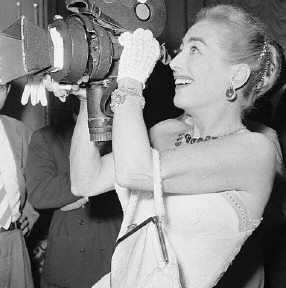 Whatever the
path that leads to the discovery of Joan's body of film work, Cukor was right:
Joan Crawford will never die. Obviously, celluloid and VHS/DVD and now digital
have in themselves already
granted immortality to certain films and their stars. And the media
certainly have been fascinated by Joan Crawford for the past nearly-100 years. But that's either
a cold, "officially historical" kind of permanence (in the former
case) or an ephemeral, arbitrary focus of the spotlight (in the latter case). Crawford's
own immortality has been achieved, and will continue to be achieved, on an individual
and personal level, as it has been since her film debut in 1925---every
time a viewer has gotten, or will get, a jolt from Dangerous Diana's exuberant Charleston,
or Vienna's eyes blazing as she stands atop that staircase,
or Lane Bellamy's death-wrestle with Titus Semple, or Myra Hudson's nerve-wracking
wait in the closet, or Flaemmchen's freshness and verve, or Helen Wright's lushly
gorgeous angst, or
Sadie Thompson's indignant anger, or Crystal Allen's bitchy audacity, or Janie Barlow's naive spunk, or Blanche Hudson's masochistic ordeal...
Whatever the
path that leads to the discovery of Joan's body of film work, Cukor was right:
Joan Crawford will never die. Obviously, celluloid and VHS/DVD and now digital
have in themselves already
granted immortality to certain films and their stars. And the media
certainly have been fascinated by Joan Crawford for the past nearly-100 years. But that's either
a cold, "officially historical" kind of permanence (in the former
case) or an ephemeral, arbitrary focus of the spotlight (in the latter case). Crawford's
own immortality has been achieved, and will continue to be achieved, on an individual
and personal level, as it has been since her film debut in 1925---every
time a viewer has gotten, or will get, a jolt from Dangerous Diana's exuberant Charleston,
or Vienna's eyes blazing as she stands atop that staircase,
or Lane Bellamy's death-wrestle with Titus Semple, or Myra Hudson's nerve-wracking
wait in the closet, or Flaemmchen's freshness and verve, or Helen Wright's lushly
gorgeous angst, or
Sadie Thompson's indignant anger, or Crystal Allen's bitchy audacity, or Janie Barlow's naive spunk, or Blanche Hudson's masochistic ordeal...
A single initial jolt of emotional recognition, of connection. Followed later, perhaps, by sheer admiration not only for the woman's artistry, but also for her intense struggle for expression and survival in a world that counted her out on numerous occasions.
A bow to a brave, audacious soul. Joan Crawford lives.
Stephanie Jones
Austin, Texas 2004/2024